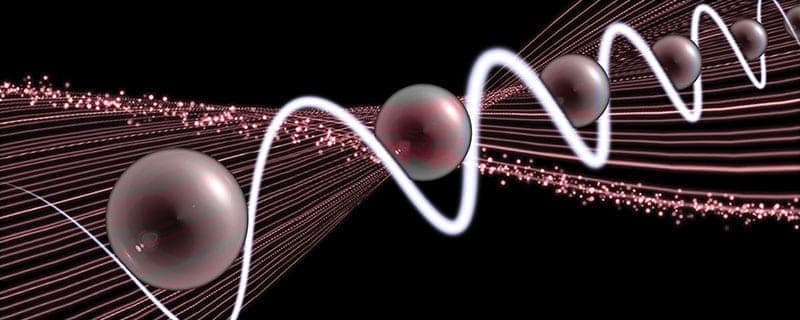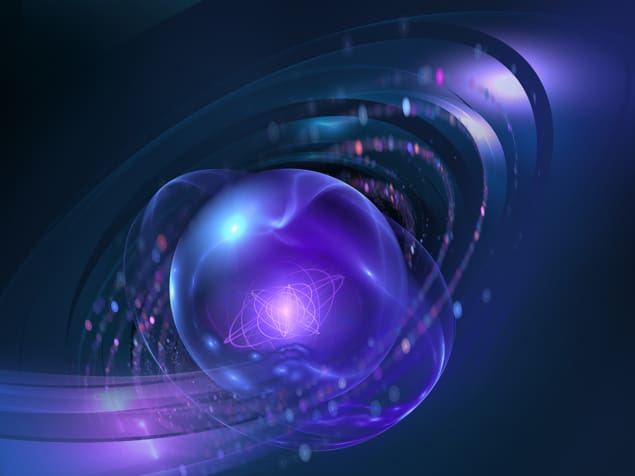Atomic quantum processors make their debut
27 Apr 2022
The first quantum processors that use neutral atoms as qubits have been produced independently by two US-based groups. The result is a milestone because atomic quantum computers may be easier to scale up than devices based on superconducting circuits or trapped ions – the two technologies that have dominated so far.
The first qubits were demonstrated in 1995 in trapped ions by David Wineland, Chris Monroe and colleagues at NIST in Boulder, Colorado, US. More recently, companies such as Google and IBM have produced computers using solid-state superconducting qubits, with the 127-qubit IBM Eagle processor currently regarded as the most powerful. However, as quantum computers have grown ever larger, this platform has encountered problems. Superconducting qubits must be constructed individually, making it near-impossible to fabricate identical copies. This compromises the “gate fidelity” (the probability of the output being correct). Moreover, each qubit must be cooled close to absolute zero – a task that becomes ever more difficult as qubit numbers increase.
Other companies – including Monroe’s own start-up, IonQ – have turned to trapped ions as an alternative. In September 2020, the industrial giant Honeywell announced that its trapped ion computer had achieved a record “quantum volume” – a measure of the computer’s capabilities and error rates. Trapped-ion computers have the advantage that each ion is guaranteed indistinguishable by the laws of quantum mechanics, while ions in a vacuum are relatively easy to isolate from thermal noise. The problem is that “ions are strongly interacting and you need to move them around with electric fields,” says Dolev Bluvstein of Harvard University in the US. “This is pretty hard in practice.”
In 2016, Mikhail Lukin of Harvard, together with colleagues at the Massachusetts Institute of Technology (MIT) and, independently, researchers at the Institut d’Optique in Paris, unveiled yet a third platform, storing quantum information in neutral atoms that they manipulated using optical tweezers. By using a laser to excite the atoms to a highly ionized Rydberg state, the researchers were able to entangle them with other atoms, allowing gate operations to be performed before the output of the gate was stored stably once again. However, nobody has previously demonstrated a full quantum circuit using neutral atoms.
Hyperfine states
In the latest research, both teams stored quantum information in the hyperfine states of alkali atoms: rubidium for Bluvstein and colleagues led by Lukin, and caesium for a team led by Mark Saffman of the University of Wisconsin-Madison, together with scientists from the quantum firms ColdQuanta and Riverlane. Bluvstein explains that these hyperfine states have several advantages. “If you have two atoms in a hyperfine state next to each other, because they’re so robust they don’t do anything,” he says. “So if we want to entangle two atoms on demand, we simultaneously try to excite both of them to the Rydberg state. These Rydberg states are huge and really strongly interacting, and that allows us to entangle the atoms really quickly. Now we come back down to the hyperfine state, safe and sound, where the entangled atoms are robust to the optical tweezer.”
The Harvard-MIT group used this robustness to physically separate the entangled atoms without causing them to decohere (that is, to lose their quantum information). When each atom arrives at its destination, another pulse from the laser entangles it with the next atom. This enables the group to perform non-local quantum gate operations without needing photonic or atomic links to move entanglement around the circuit.
The researchers used this protocol to execute several programs. Notably, they prepared a “logical qubit” made up of seven physical qubits that could encode information in an error-resistant fashion. Bluvstein notes that entangling multiple logical qubits would be much simpler in his team’s system than in alternatives that use static qubits. “There’s a lot of different tricks called braiding or lattice surgery that people work to entangle logical qubits,” he explains, “but once you have the movement of atoms, and once you can interlace them, it’s very simple: all you have to do is make two of them independently, move each group of qubits, interlace it with the other group, pulse the Rydberg laser once and do a gate between them.” This flexibility, Bluvstein says, should allow researchers to perform quantum error correction and entanglement between logical qubits “in a way that simply is not possible with superconducting qubits or trapped ions”.
Precision control
The Wisconsin group took a different tack. Instead of physically moving their atoms, they used precision-controlled laser light to manipulate the atoms’ Rydberg excitations and transfer entanglement around the lattice. “Imagine you have three qubits in a line,” Saffman explains. “I’m going to take two laser beam spots and illuminate the left-most one and the centre one. They get excited to the Rydberg state, they interact, they become entangled.” The next step, Saffman continues, is to move the laser beams to illuminate the centre atom and the right one that was previously inactive and excite both to the Rydberg state. In this fashion, he concludes, “the laser beams are controlling the gate operations but the actual linking mechanisms are the atomic Rydberg interactions”.
Saffman’s group demonstrated the power of their scheme by producing six-atom states known as Greenberger-Horne-Zeilinger states, which are sometimes termed Schrödinger cat states because they have the strongest possible non-local correlations of all multi-particle quantum states. The Wisconsin team also showed that their system could act as a quantum simulator by performing various quantum phase estimation problems, such as estimating the energy of a hydrogen molecule.
By keeping the atoms static, the Wisconsin team achieved a clock speed several hundred times faster than the Harvard-MIT group, albeit with some loss in flexibility. “Ultimately I think these two approaches may well be combined into a single, more powerful system, but right now they’re two fascinating examples of the multiplicity of approaches one can take,” Saffman says.READ MORE

Hannah Williams, an atomic physicist at Durham University in the UK who was not involved in the research, says that both groups have shown “the ability of the platform and its promise for quantum computing by demonstrating iconic quantum algorithms, be that error correction or phase estimation”. However, she cautions that the gate fidelities need to be improved and the number of atoms increased before the system is truly competitive. “The selling point of neutral atomic systems is always that they should be really easy to scale, and the demonstrations were on at most 24 qubits,” she says.
Monroe agrees, adding that he believes the two challenges are connected. “It doesn’t really matter how many qubits you have,” he says. “If you can only run at 95% fidelity, you can only link together 20 or so operations.” He also notes that gate fidelities in atomic systems are currently far too low to benefit from the quantum error correction code demonstrated by Lukin’s group. Nevertheless, he says the groups are “doing the right thing”, adding that atomic qubits have the potential to hit 99.9% fidelity without error correction. “We’re already doing that with trapped ions, and though the neutrals are behind, I don’t have any doubt that they will eventually get there and derive benefit from these very efficient codes,” Monroe concludes.
Tim Wogan is a science writer based in the US
from physicsworld.com 1/5/2022

Δεν υπάρχουν σχόλια:
Δημοσίευση σχολίου